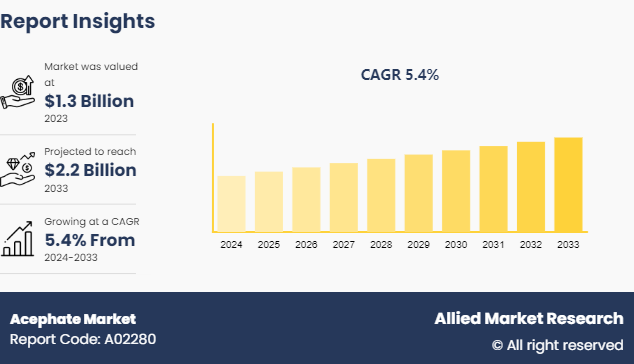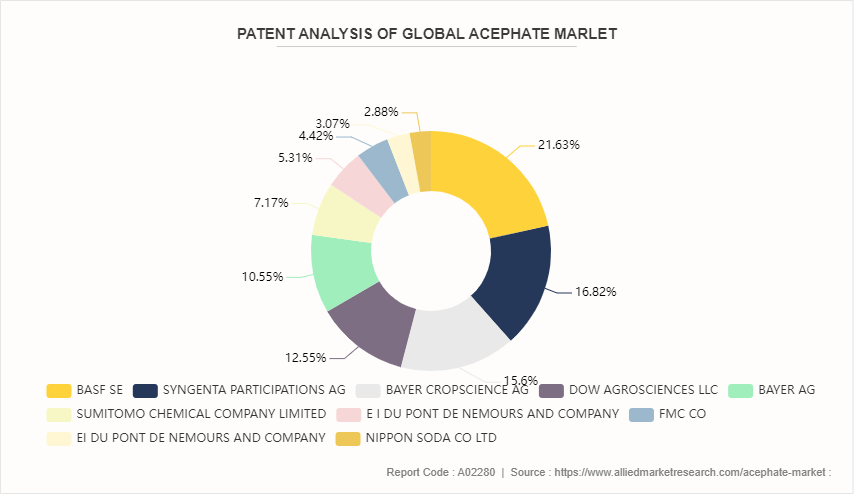Acephate Market Research, 2033
The global acephate market was valued at $1.3 billion in 2023, and is projected to reach $2.2 billion by 2033, growing at a CAGR of 5.4% from 2024 to 2033.

Market Introduction and Definition
Acephate is an organophosphate insecticide used primarily for agricultural purposes. It works by inhibiting acetylcholinesterase, an enzyme essential for proper nerve function in insects, leading to their paralysis and eventual death. Acephate is effective against a wide range of pests, including aphids, thrips, caterpillars, and beetles, making it valuable for controlling crop damage. Its systemic action allows for both foliar and soil application, providing flexibility in pest management strategies. Additionally, its relatively low mammalian toxicity and short residual activity make it a preferred choice among farmers. However, careful application and adherence to safety guidelines are crucial to minimize environmental impact and risks to non-target organisms.
Key Takeaways
- The report provides competitive dynamics by evaluating business segments, product portfolios, target market revenue, geographical presence and key strategic developments by prominent manufacturers.
- The study contains qualitative information such as the market dynamics (drivers, restraints, challenges, and opportunities) , public policy analysis, pricing analysis, and Porter’s Five Force Analysis across North America, Europe, Asia-Pacific, LAMEA regions.
- Latest trends in global acephate market such as undergoing R&D activities, regulatory guidelines, and government initiatives are analyzed across 16 countries in 4 different regions.
- More than 1, 400 acephate -related product literatures, industry releases, annual reports, and other such documents of key industry participants along with authentic industry journals and government websites have been reviewed for generating high-value industry insights for global acetal copolymer market.
Key Market Dynamics
Growing population base has led to increasing demand for crops which in turn has surged the need for effective protective solutions in the growing agriculture sector. Furthermore, the global agricultural sector is facing challenges from unwanted insect pests that causes damage to crop and reduces the yield. Hence, farmers and agribusinesses are utilizing acephate to maximize crop yield and minimize crop damage. According to an article published by The Times of India in 2024, the domestic agrochemicals market is projected to reach $13.08 billion by 2029. This factor may act as one of the key drivers responsible for the growth of the acephate market during the forecast period.
Additionally, technological advancements and innovations in agricultural practices are also key drivers of the acephate market. The development of advanced formulation technologies has enhanced the efficiency and safety of acephate, making it more user-friendly and environmentally acceptable. Innovations such as controlled-release formulations, microencapsulation, and improved application techniques have reduced the environmental footprint of acephate while maintaining its insecticidal efficacy. Additionally, precision agriculture technologies, which utilize data and automation to optimize pesticide application, have increased the efficiency of acephate use. These technologies ensure that acephate is applied in the right amounts and at the right times, minimizing waste and reducing the potential for negative environmental impacts. As the agricultural sector continues to embrace digital tools and smart farming practices, the demand for effective and adaptable insecticides like acephate is expected to grow.
However, regulatory policies and frameworks significantly impact the acephate market. In many countries such as the U.S., Canada, Germany, UK, and others the registration, sale, and use of acephate is strictly regulated to ensure environmental and human safety. These regulations may hinder the growth of the acephate market during the forecast period. On the contrary, the growing emphasis on sustainable agriculture and the adoption of integrated pest management (IPM) practices present another significant opportunity for the acephate market. IPM strategies aim to manage pest populations in an ecologically balanced manner, using a combination of biological, cultural, mechanical, and chemical control methods. Acephate's role in IPM can be pivotal, particularly as a chemical control option that complements other methods.
The systemic nature of acephate allows it to control pests that may be missed by contact insecticides, making it a valuable tool in IPM programs. Additionally, its broad-spectrum activity can help manage multiple pest species simultaneously, reducing the need for multiple insecticide applications. This factor may create remunerative opportunities for the acephate market during the forecast period.

Key patent holders in the gallic acid market include agricultural companies, research institutions, universities, and chemical manufacturers. Companies such as BASF SE, SYNGENTA PARTICIPATIONS AG, BAYER CROPSCIENCE AG, DOW, BAYER AG, SUMITOMO CHEMICAL COMPANY LIMITED, DU PONT, FMC CO, and NIPPON SODA CO LTD hold significant patent portfolios covering various aspects of acephate production, formulation, and applications. Research institutions and universities contribute to patent filings related to novel uses and synthesis methods of acephate.
Market Segmentation
The acephate market is segmented on the basis by form, application method, application, and region. By form, the market is classified into granule and spray/pellet. Based on application method, the market is segmented into spraying, dipping, hand dressing, and others. By application, the market is classified into agriculture, forestry, horticulture, and others. Region-wise the market is studied across areas such as North America, Europe, Asia-Pacific, and LAMEA.
Regional/Country Market Outlook
Asia-Pacific represents a significant market for acephate, driven by rapid population growth coupled with decrease in arable land which in turn has led farmers to utilize various agrochemicals in order to increase crop yield. Acephate is widely used in crops as insecticides to control various insects such as aphids, thrips, and whiteflies. Thus, the increasing demand for acephate in the growing agriculture sector in the Asia-Pacific region may lead the acephate market to witness a significant growth.
Moreover, the Asia-Pacific is witnessing rapid urbanization which in turn has surged the construction of commercial buildings, amusement parks, public spaces, and others wherein acephate is widely used as insecticide in lawns and gardens. This may further augment the growth of the acephate market in the Asia-Pacific region.
Additionally, the Asia-Pacific region encompasses a wide range of climatic zones, from tropical to temperate, which are conducive to the proliferation of various agricultural pests. Insects like aphids, whiteflies, and caterpillars pose a significant threat to crop yields and quality. Countries such as India, China, and Thailand rely heavily on agriculture, with large areas devoted to the cultivation of crops like rice, cotton, vegetables, and fruits. Acephate's broad-spectrum activity and systemic properties make it a preferred choice for managing these pests effectively.
Competitive Landscape
The major players operating in the acephate market include Shiv Agro Chemicals, Ram Shree Chemicals, Vizag Chemicals, Bayer AG, Sinon Chemical Group, Drexel Chemical Company, ADAMA Limited, Zhengzhou Delong Chemical Co., Ltd., Rallis India Limited, and Habei Veyong Bio-Chemical Co. Ltd. Other players in the acephate market include Aristo Biotech, Fine Pest Sulphur (India) Pvt. Ltd., and so on.
Industry Trends
- According to a report published by the Journal of Pesticide Science in 2022, the trend of insecticide development is changing from organophosphorus, carbamate, and synthetic pyrethroids to nicotinic and diamide insecticides. This is attributed to rise in regulatory pressures among the pesticides manufacturers.
- According to an article published by a science magazine named Nature in 2021, a novel insecticide has been developed with zero or no insecticide resistance. This may surge the utilization of the new insecticide across agriculture, horticulture, and other crop protection applications.
Public Policy Analysis of Global Acephate Market
Several acts and regulations have been imposed in order to avoid safeguard the manufacturing and utilization of acephate for application in various end-use sectors. For instance:
- In U.S, Federal Insecticide, Fungicide, and Rodenticide Act (FIFRA) (EPA Reg. No. 239-2461) governs the registration, distribution, sale, and use of pesticides. Acephate must be registered with the EPA before it can be sold or used in the U.S.
- In Europe, Regulation (EC) No 1107/2009 governs the placing of plant protection products on the market within the EU. Acephate must be approved under this regulation to be used in any EU member state.
- Moreover, acephate is not approved for use in the EU, following its non-inclusion in Annex I of Directive 91/414/EEC and subsequent regulations under Regulation (EC) No 1107/2009. It was effectively banned in the EU due to concerns about its environmental and human health impacts.
- In Japan, manufacturing and sales of acephate is regulated under the Agricultural Chemicals Regulation Law.
- In China, Ministry of Agriculture and Rural Affairs (MARA) regulates pesticides under the Regulation on Pesticide Administration. Maximum residue limit (MRLs) are established by the National Food Safety Standard GB 2763-2019. The MRL for acephate on rice is 0.05 mg/kg.
Key Sources Referred
- National Promotion and Facilitation Agency
- BioMed Central
- U.S. Development Authority
- United States Department of Agriculture
- Science Direct
- U.S. Food and Agriculture Organization (U.S. FAO)
- Invest In India
- Press Information Bureau
- American Farm Bureau Federation
Key Benefits For Stakeholders
- This report provides a quantitative analysis of the market segments, current trends, estimations, and dynamics of the acephate market analysis from 2024 to 2033 to identify the prevailing acephate market opportunities.
- The market research is offered along with information related to key drivers, restraints, and opportunities.
- Porter's five forces analysis highlights the potency of buyers and suppliers to enable stakeholders make profit-oriented business decisions and strengthen their supplier-buyer network.
- In-depth analysis of the acephate market segmentation assists to determine the prevailing market opportunities.
- Major countries in each region are mapped according to their revenue contribution to the global market.
- Market player positioning facilitates benchmarking and provides a clear understanding of the present position of the market players.
- The report includes the analysis of the regional as well as global acephate market trends, key players, market segments, application areas, and market growth strategies.
Acephate Market Report Highlights
| Aspects | Details |
| Market Size By 2033 | USD 2.2 Billion |
| Growth Rate | CAGR of 5.4% |
| Forecast period | 2024 - 2033 |
| Report Pages | 350 |
| By Form |
|
| By Application Method |
|
| By Application |
|
| By Region |
|
| Key Market Players | Bayer AG, Drexel Chemical Company, Vizag Chemicals, ADAMA Limited, Shiv Agro Chemicals, Rallis India Limited, Sinon Chemical Group, Zhengzhou Delong Chemical Co., Ltd., Habei Veyong Bio-Chemical Co. Ltd., Ram Shree Chemicals |
| Other Key Market Players | Gujarat Pesticides Private Limited DuPont Dongjin Chemical |
Loading Table Of Content...



